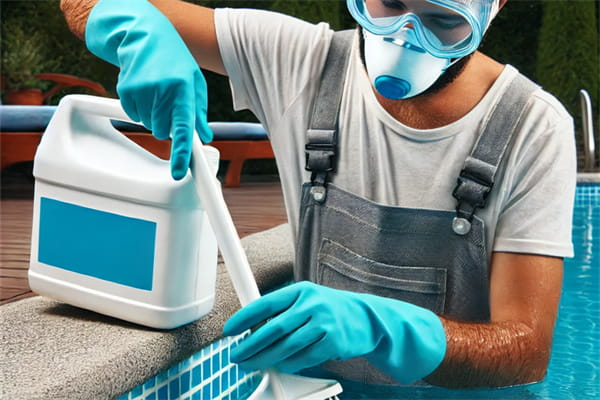Algae can turn your pristine pool, pond, or aquarium into an unsightly mess, causing issues from murky water to clogged filters. This is where algaecides come into play. Algaecides are essential tools in maintaining clean and safe water environments. This post will guide you through effective algae control by understanding and using algaecides. We’ll explore what algaecides are, how they work, the different types available, their applications, and the benefits they offer.

Ⅰ. What is Algaecide?
Algaecide is a chemical treatment designed to kill or inhibit the growth of algae in water systems. Algae, which are simple photosynthetic organisms, can proliferate rapidly in water, leading to various problems, including murky water, slippery surfaces, and clogged filters. Algaecides are used to maintain clean, clear water by preventing and controlling algae blooms.
Ⅱ. How Algaecides Work
1.Disruption of Photosynthesis
One of the primary ways algaecides work is by disrupting the photosynthesis process. Algae rely on photosynthesis to produce food, and algaecides can interfere with this process, effectively starving the algae.
2.Cellular Damage
Some algaecides cause physical damage to algae cells, leading to their death. This can include breaking down cell walls or disrupting internal cellular functions, which causes the algae to die off.
3.Nutrient Deprivation
Certain algaecides work by limiting the availability of essential nutrients needed for algae growth. By depriving algae of these nutrients, algaecides can prevent their proliferation and control their presence in the water.
Ⅲ. Types of Algaecides
1.Chemical Algaecides
a.Copper-Based Algaecides
Copper-based algaecides are among the most common types used. They are highly effective against a wide range of algae. However, they can cause staining if not used properly and should be used with caution.
b.Quaternary Ammonium Compounds (Quats)
Quats are effective against green algae and are relatively inexpensive. However, they can cause foaming, which might not be desirable in all water systems.
c.Polyquaterniums (Polyquats)
Polyquats are non-foaming and more effective against a broader range of algae types, including filamentous algae. They are a popular choice for many pool and pond owners.
2.Natural Algaecides
a.Barley Straw
Barley straw is a natural algaecide that releases compounds inhibiting algae growth as it decomposes. It’s a great option for those looking for a more organic approach to algae control.
b.Beneficial Bacteria
Beneficial bacteria can compete with algae for nutrients, reducing their growth. This method is also considered environmentally friendly and sustainable.
3.Specialized Algaecides
a.Broad Spectrum Algaecides
Broad spectrum algaecides are effective against multiple types of algae, making them a versatile option for general algae control.
b.Targeted Algaecides
Targeted algaecides are designed to combat specific types of algae. This can be particularly useful in situations where a specific type of algae is causing problems.
Ⅳ. Applications of Algaecides
1.Pools and Spas
a.Residential Pools
Algaecides are commonly used in residential pools to keep the water clean and safe for swimming. Regular use of algaecides can prevent algae blooms, ensuring that the pool remains clear and inviting.
b.Commercial Pools
In commercial pools, such as those found in hotels or community centers, maintaining clean and algae-free water is crucial for health and safety reasons. Algaecides play a vital role in achieving this goal.
2.Ponds and Lakes
a.Garden Ponds
In garden ponds, algae can not only spoil the appearance but also disrupt the ecological balance. Using algaecides can help maintain both the aesthetic and ecological health of the pond.
b.Larger Water Bodies
Managing algae in larger water bodies like public or recreational lakes is essential for environmental and recreational purposes. Algaecides can be used to control algae blooms, ensuring the water remains usable and safe.
3.Aquariums
a.Home Aquariums
In home aquariums, algae can quickly become a nuisance, affecting both the appearance and health of the aquatic environment. Algaecides can help maintain a healthy environment for fish and plants.
b.Public Aquariums
Public aquariums require meticulous care to keep exhibits clear and algae-free. Using algaecides is a crucial part of maintaining these displays for public viewing.
Ⅴ. Advantages and Benefits of Algaecides

1.Water Clarity
One of the most apparent benefits of using algaecides is maintaining crystal-clear water. This not only enhances the aesthetic appeal but also improves the overall water quality.
2.Health and Safety
Algae blooms can produce harmful toxins that pose health risks to humans and animals. By preventing and controlling algae growth, algaecides help ensure that the water remains safe for use.
3.Cost Efficiency
Regular use of algaecides can save money in the long run by reducing the need for frequent water changes and extensive cleaning. This can be particularly beneficial for larger water systems.
4.Ease of Maintenance
Algaecides simplify the process of keeping water systems clean. By preventing algae growth, they reduce the amount of manual cleaning required, making maintenance more manageable.
5.Versatility
Algaecides are versatile and can be used in various water systems, including pools, ponds, and aquariums. This makes them an invaluable tool for anyone responsible for maintaining water environments.
Ⅵ. Conclusion
In summary, algaecides are essential for effective algae control in pools, ponds, and aquariums. Understanding what algaecides are, how they work, the different types available, their applications, and the benefits they offer can help you maintain clean and healthy water environments. By incorporating algaecides into your regular maintenance routine, you can ensure that your water systems remain clear, safe, and beautiful. Upgrade your algae control strategy today and experience the difference these advanced products can make.
 Instant
Quote
Instant
Quote Email
Us
Email
Us